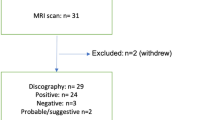Abstract
Objectives
To evaluate glycosaminoglycan-dependent chemical exchange saturation transfer (gagCEST) imaging at 3-T magnetic resonance imaging (MRI) for quantification of glycosaminoglycan (GAG) content in intervertebral discs (IVDs) in patients with low-back pain (LBP).
Methods
Sixteen patients with LBP were examined in this Institutional Review Board-approved study using a clinical whole-body system. The MRI protocol included standard morphological imaging, sagittal T2-mapping and gagCEST imaging. IVD grading according to the Pfirrmann score and region-of-interest analysis of the annulus fibrosus (AF) and the nucleus pulposus (NP) in gagCEST and T2 maps were performed before data were statistically tested for correlations between imaging techniques and quantitative differences between different grades of IVD degeneration.
Results
GagCEST values of the NP were significantly (P < 0.001) lower in degenerative IVDs (Pfirrmann 3 + 4) compared with non-degenerative IVDs (Pfirrmann 1 + 2), but only a weak linear correlation (r = 0.299) with the T2 relaxation times was found. GagCEST values of the NP exhibited a moderate negative correlation with Pfirrmann grades (r = −0.449).
Conclusions
The known loss of GAG in the NP with increasing grade of morphological degeneration can be assessed using gagCEST imaging at 3.0 T. The correlation with single Pfirrmann grades and T2 relaxation times only seems to be moderate, indicating a substantial difference in information provided by the techniques.
Key Points
• 3-T MRI offers new functional data about the degenerating lumbar disc
• GagCEST imaging can assess glycosaminoglycan loss
• GagCEST imaging and T2 mapping provide substantially different information about disc degeneration
• Correlation between glycosaminoglycan loss and grade of morphological degeneration is only moderate




Similar content being viewed by others
Abbreviations
- AF:
-
Annulus fibrosus
- GAG:
-
Glycosaminoglycan
- gagCEST:
-
Glycosaminoglycan-dependent chemical exchange saturation transfer
- IVD:
-
Intervertebral disc
- LBP:
-
Low-back pain
- NP:
-
Nucleus pulposus
References
Airaksinen O, Brox JI, Cedraschi C et al (2006) Chapter 4. European guidelines for the management of chronic nonspecific low back pain. Eur Spine J 15(Suppl 2):S192–S300
Andersson GB (1999) Epidemiological features of chronic low-back pain. Lancet 354:581–585
Balague F, Mannion AF, Pellise F, Cedraschi C (2012) Non-specific low back pain. Lancet 379:482–491
Becker A, Held H, Redaelli M et al (2012) Implementation of a guideline for low back pain management in primary care: a cost-effectiveness analysis. Spine (Phila Pa 1976) 37:701–710
Chou R, Fu R, Carrino JA, Deyo RA (2009) Imaging strategies for low-back pain: systematic review and meta-analysis. Lancet 373:463–472
Deyo RA, Mirza SK, Martin BI (2006) Back pain prevalence and visit rates: estimates from U.S. national surveys, 2002. Spine (Phila Pa 1976) 31:2724–2727
Eyre DR, Muir H (1977) Quantitative analysis of types I and II collagens in human intervertebral discs at various ages. Biochim Biophys Acta 492:29–42
Graves JM, Fulton-Kehoe D, Jarvik JG, Franklin GM (2012) Early imaging for acute low back pain: one-year health and disability outcomes among Washington State workers. Spine (Phila Pa 1976)
Hart LG, Deyo RA, Cherkin DC (1995) Physician office visits for low back pain. Frequency, clinical evaluation, and treatment patterns from a U.S. national survey. Spine (Phila Pa 1976) 20:11–19
Insko EK, Clayton DB, Elliott MA (2002) In vivo sodium MR imaging of the intervertebral disk at 4 T. Acad Radiol 9:800–804
Jarvik JG, Deyo RA (2000) Imaging of lumbar intervertebral disk degeneration and aging, excluding disk herniations. Radiol Clin North Am 38:1255–1266
Jarvik JG, Hollingworth W, Martin B et al (2003) Rapid magnetic resonance imaging vs radiographs for patients with low back pain: a randomized controlled trial. JAMA 289:2810–2818
Kim M, Chan Q, Anthony MP, Cheung KM, Samartzis D, Khong PL (2011) Assessment of glycosaminoglycan distribution in human lumbar intervertebral discs using chemical exchange saturation transfer at 3 T: feasibility and initial experience. NMR Biomed 24:1137–1144
Lyons G, Eisenstein SM, Sweet MB (1981) Biochemical changes in intervertebral disc degeneration. Biochim Biophys Acta 673:443–453
Mehra M, Hill K, Nicholl D, Schadrack J (2012) The burden of chronic low back pain with and without a neuropathic component: a healthcare resource use and cost analysis. J Med Econ 15:245–252
Meisel HJ, Siodla V, Ganey T, Minkus Y, Hutton WC, Alasevic OJ (2007) Clinical experience in cell-based therapeutics: disc chondrocyte transplantation A treatment for degenerated or damaged intervertebral disc. Biomol Eng 24:5–21
Pfirrmann CW, Metzdorf A, Zanetti M, Hodler J, Boos N (2001) Magnetic resonance classification of lumbar intervertebral disc degeneration. Spine (Phila Pa 1976) 26:1873–1878
Saar G, Zhang B, Ling W, Regatte RR, Navon G, Jerschow A (2012) Assessment of glycosaminoglycan concentration changes in the intervertebral disc via chemical exchange saturation transfer. NMR Biomed 25:255–261
Sheehan NJ (2010) Magnetic resonance imaging for low back pain: indications and limitations. Ann Rheum Dis 69:7–11
Stelzeneder D, Welsch GH, Kovacs BK et al (2012) Quantitative T2 evaluation at 3.0 T compared to morphological grading of the lumbar intervertebral disc: a standardized evaluation approach in patients with low back pain. Eur J Radiol 81:324–330
Trattnig S, Stelzeneder D, Goed S et al (2010) Lumbar intervertebral disc abnormalities: comparison of quantitative T2 mapping with conventional MR at 3.0 T. Eur Radiol 20:2715–2722
Urban JP, McMullin JF (1985) Swelling pressure of the inervertebral disc: influence of proteoglycan and collagen contents. Biorheology 22:145–157
Urban JP, Winlove CP (2007) Pathophysiology of the intervertebral disc and the challenges for MRI. J Magn Reson Imaging 25:419–432
van Zijl PC, Yadav NN (2011) Chemical exchange saturation transfer (CEST): what is in a name and what isn’t? Magn Reson Med 65:927–948
Acknowledgements
The study was supported by funding from the Vienna Clinical Imaging Centre (VIACLIC) project as part of the Vienna Spots of Excellence (VSOE) Program and Siemens Healthcare. This study was supported non-financially by the Proof-of-Concept program of Euro-BioImaging.
Author information
Authors and Affiliations
Corresponding author
Rights and permissions
About this article
Cite this article
Haneder, S., Apprich, S.R., Schmitt, B. et al. Assessment of glycosaminoglycan content in intervertebral discs using chemical exchange saturation transfer at 3.0 Tesla: preliminary results in patients with low-back pain. Eur Radiol 23, 861–868 (2013). https://doi.org/10.1007/s00330-012-2660-6
Received:
Revised:
Accepted:
Published:
Issue Date:
DOI: https://doi.org/10.1007/s00330-012-2660-6




